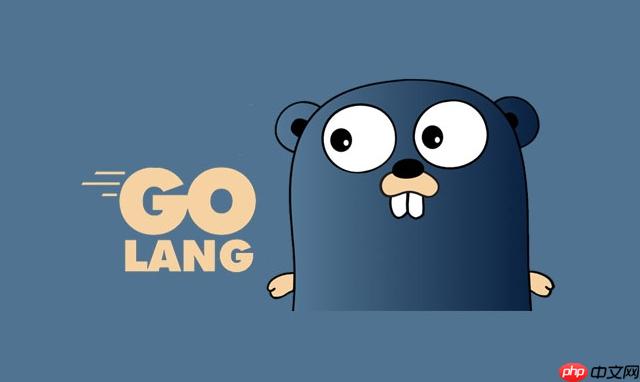Golang中通过goroutine和channel实现生产者消费者模型,利用缓冲channel提升吞吐量,close通知结束,range自动检测关闭;结合sync.WaitGroup协调消费者退出,context控制超时与取消,确保程序健壮性。

在 Golang 中实现生产者消费者模型,核心是利用 goroutine 和 channel 实现并发任务的协同。这种模型广泛应用于需要解耦数据生成与处理的场景,比如消息队列、任务调度、日志收集等。
Go 的 channel 是天然的线程安全队列,非常适合实现生产者消费者模式。生产者将任务发送到 channel,消费者从 channel 接收并处理。
以下是一个简单示例:
package main
<p>import (
"fmt"
"time"
)</p><p>func producer(ch chan<- int) {
for i := 0; i < 5; i++ {
ch <- i
fmt.Printf("生产者: 生成 %d\n", i)
time.Sleep(100 * time.Millisecond)
}
close(ch) // 关闭 channel 表示不再生产
}</p><p>func consumer(ch <-chan int, id int) {
for data := range ch { // 自动检测 channel 是否关闭
fmt.Printf("消费者 %d: 处理 %d\n", id, data)
time.Sleep(200 * time.Millisecond)
}
}</p><p>func main() {
ch := make(chan int, 3) // 带缓冲的 channel</p><pre class='brush:php;toolbar:false;'>go producer(ch)
for i := 1; i <= 2; i++ {
go consumer(ch, i)
}
time.Sleep(2 * time.Second) // 等待执行完成}
立即学习“go语言免费学习笔记(深入)”;
说明:
close(ch) 通知消费者数据已全部发送。for-range 自动接收数据并在 channel 关闭后退出循环。实际应用中,通常固定消费者数量,并确保所有消费者处理完数据后再退出程序。可通过 sync.WaitGroup 协调。
func consumerWithWait(ch <-chan int, wg *sync.WaitGroup) {
defer wg.Done()
for data := range ch {
fmt.Printf("消费者处理: %d\n", data)
time.Sleep(150 * time.Millisecond)
}
}
<p>func main() {
ch := make(chan int, 5)
var wg sync.WaitGroup</p><pre class='brush:php;toolbar:false;'>go producer(ch)
// 启动 3 个消费者
for i := 0; i < 3; i++ {
wg.Add(1)
go consumerWithWait(ch, &wg)
}
wg.Wait() // 等待所有消费者完成
fmt.Println("所有任务处理完毕")}
立即学习“go语言免费学习笔记(深入)”;
关键点:
wg.Add(1)。wg.Done()。wg.Wait() 阻塞直到所有消费者退出。当需要提前终止生产或消费过程(如超时或中断信号),应使用 context 进行统一管理。
func producerWithContext(ctx context.Context, ch chan<- int) {
for i := 0; ; i++ {
select {
case ch <- i:
fmt.Printf("生产: %d\n", i)
time.Sleep(100 * time.Millisecond)
case <-ctx.Done():
fmt.Println("生产者收到退出信号")
close(ch)
return
}
}
}
<p>func main() {
ctx, cancel := context.WithTimeout(context.Background(), 1*time.Second)
defer cancel()</p><pre class='brush:php;toolbar:false;'>ch := make(chan int, 5)
var wg sync.WaitGroup
go producerWithContext(ctx, ch)
for i := 0; i < 2; i++ {
wg.Add(1)
go func(id int) {
defer wg.Done()
for data := range ch {
fmt.Printf("消费者 %d 处理: %d\n", id, data)
time.Sleep(200 * time.Millisecond)
}
}(i)
}
wg.Wait()
fmt.Println("程序退出")}
立即学习“go语言免费学习笔记(深入)”;
优势:
基本上就这些。Golang 的 channel + goroutine + context 组合,让生产者消费者模型既简洁又健壮。合理使用缓冲、等待组和上下文控制,能应对大多数并发协同需求。
以上就是如何在 Golang 中实现生产者消费者模型_Golang 并发任务协同设计示例的详细内容,更多请关注php中文网其它相关文章!

每个人都需要一台速度更快、更稳定的 PC。随着时间的推移,垃圾文件、旧注册表数据和不必要的后台进程会占用资源并降低性能。幸运的是,许多工具可以让 Windows 保持平稳运行。




Copyright 2014-2025 https://www.php.cn/ All Rights Reserved | php.cn | 湘ICP备2023035733号